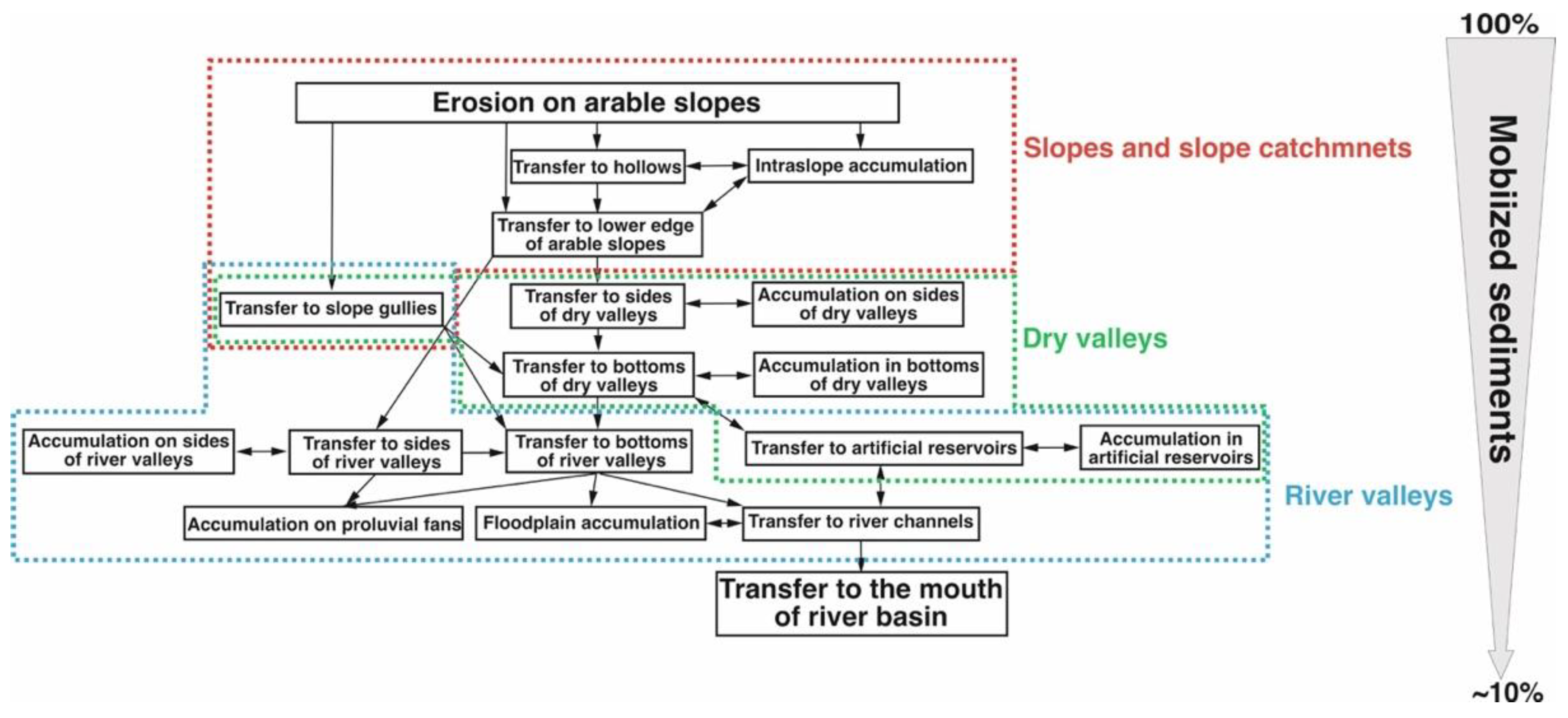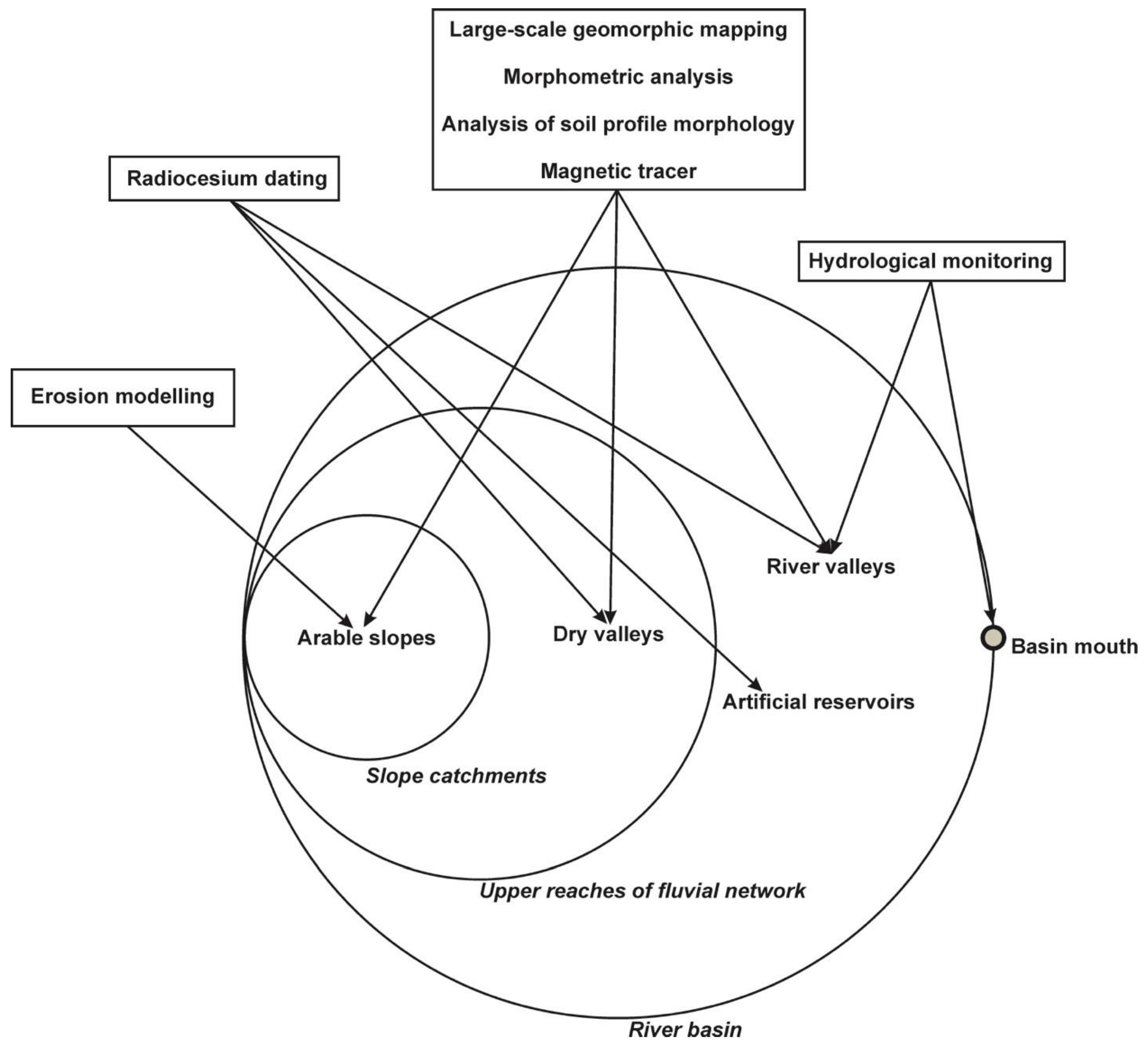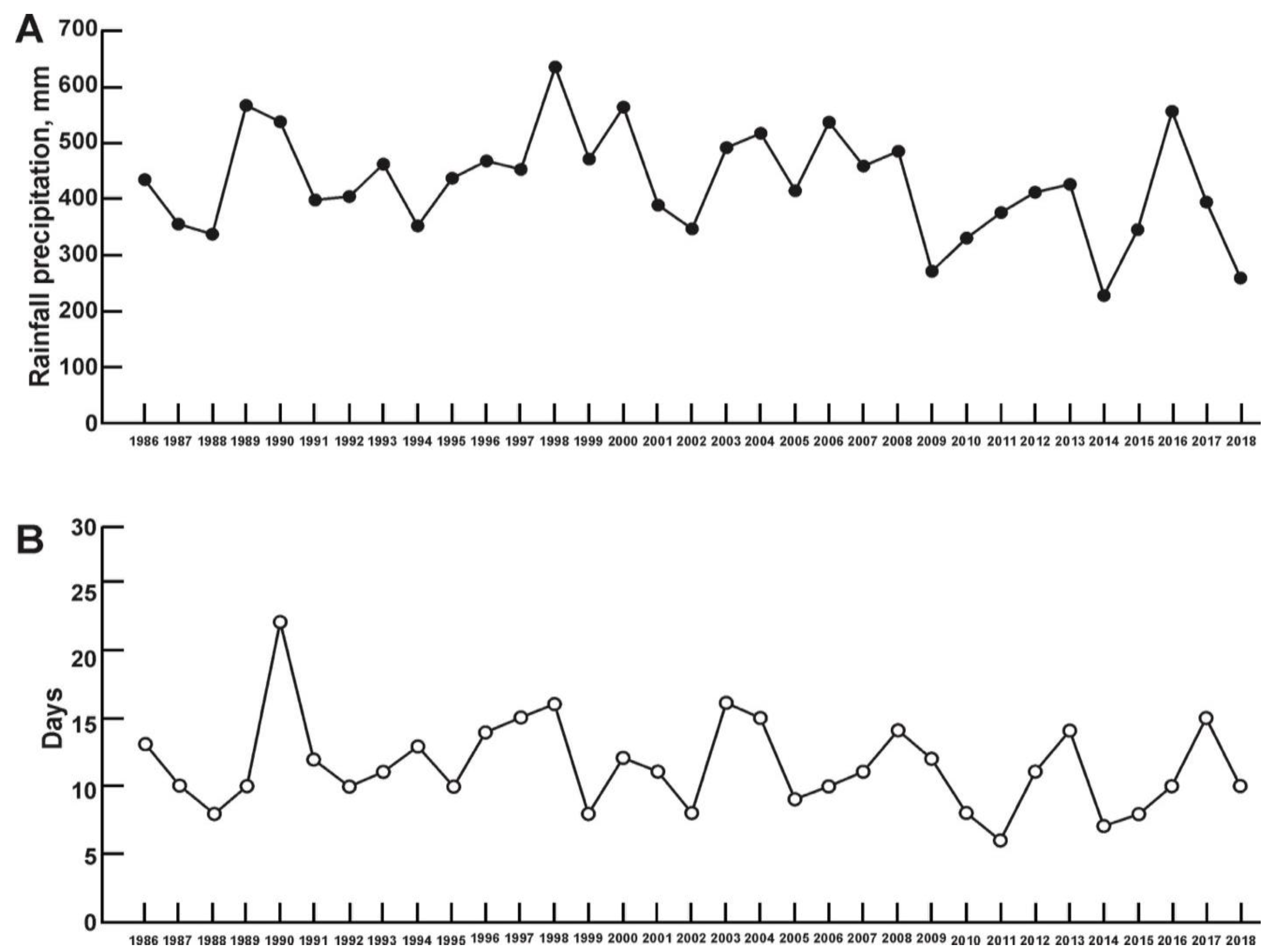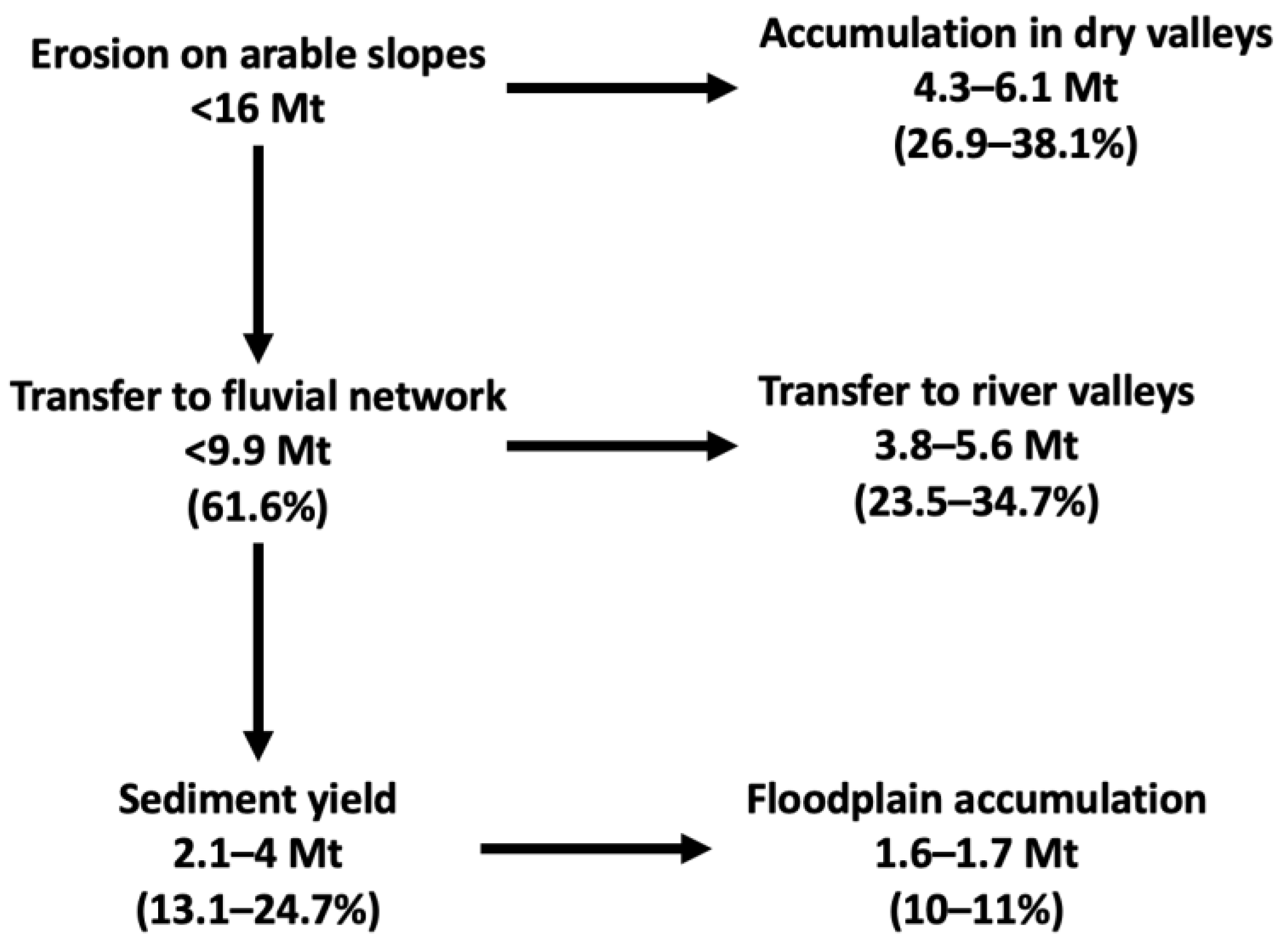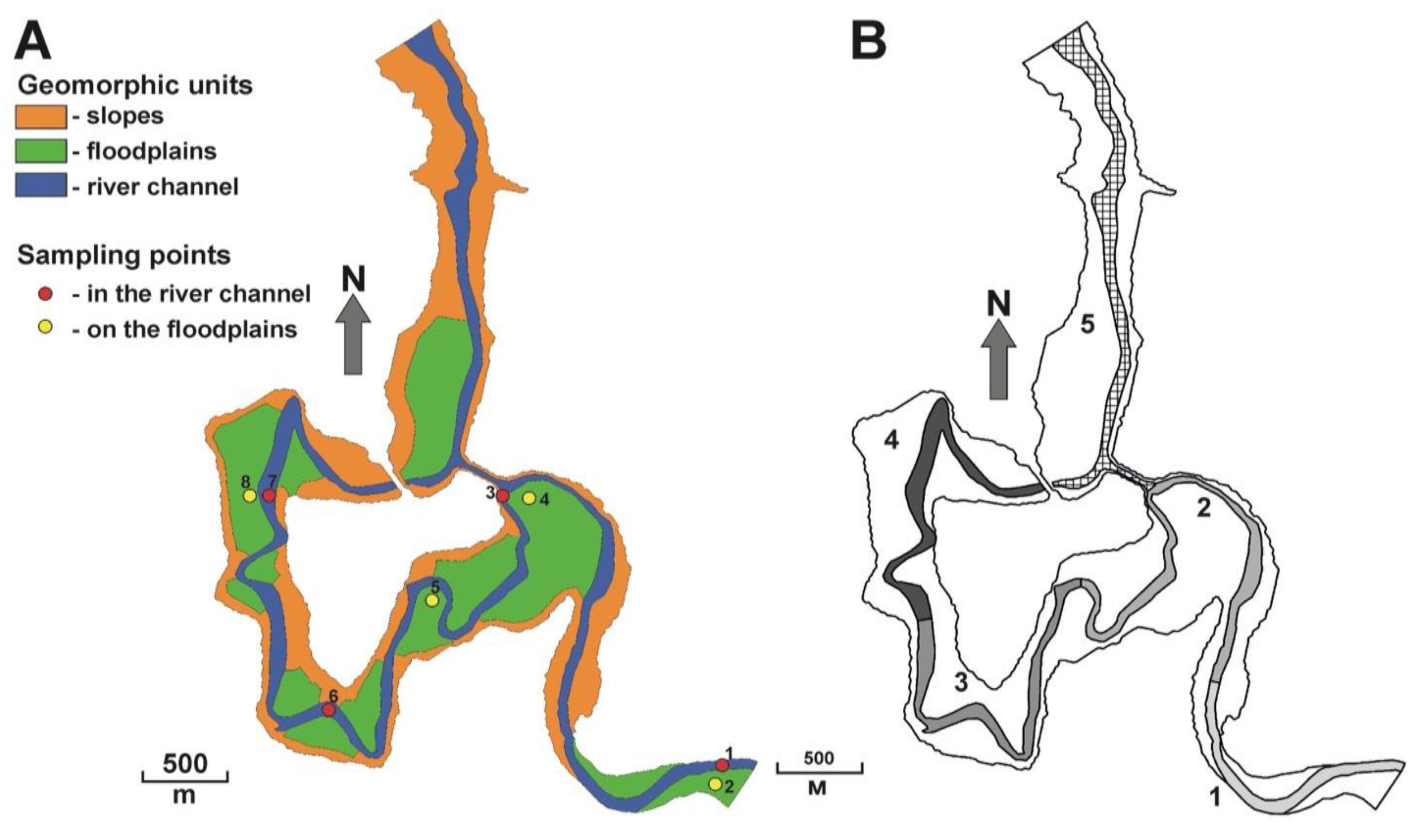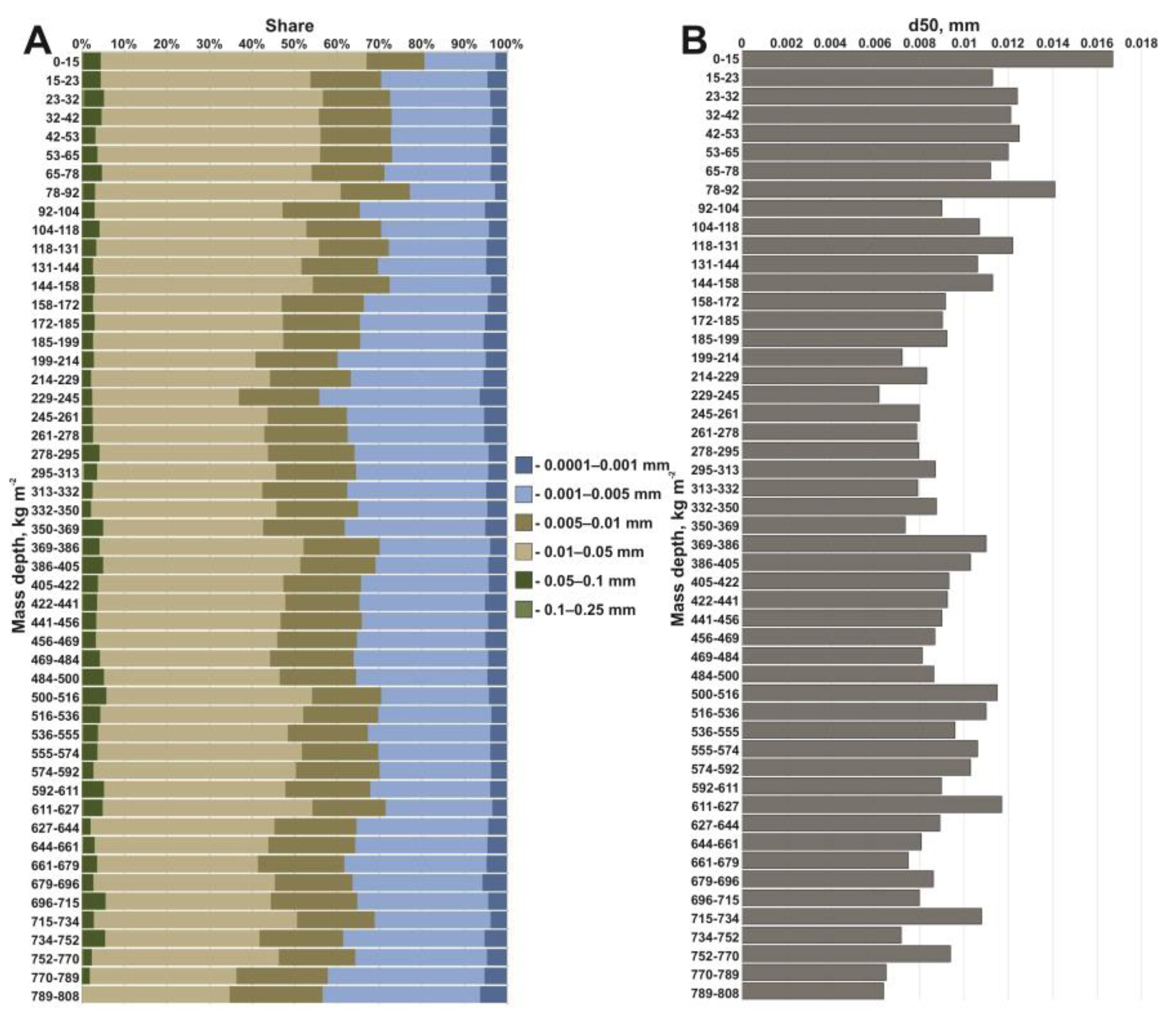1. Introduction
The sediment budget approach is a basic one in the framework of fluvial geomorphology, and it has turned out to be an effective but rather labour-intensive tool [
1,
2,
3,
4,
5]. A sediment budget study should not be considered an alternative to regular stationary observations [
6]. If monitoring data are not available or are scarce, a sediment budget is the best approach to estimate the volumes and determine the sources of the sediment flows within and beyond river basins. The spatial–temporal windows for the evaluation of the sediment budget depend on the study goals, and this approach can be used for sites within different areas [
7,
8,
9,
10,
11,
12,
13].
However, individual studies may not sufficiently cover the object under study. In this regard, summarizing a set of works is required to obtain a holistic result. Such generalizations allow working with relatively large objects from the regional [
14,
15,
16,
17,
18,
19,
20] to the global scale [
21,
22,
23,
24,
25]. The result makes it possible to find solutions to specific environmental issues [
26,
27,
28,
29,
30] and optimal land use management strategies [
31,
32,
33,
34].
We can successfully apply the sediment budget approach to mass-balance studies on the transfer of sediment-associated pollutants. Some of the pollutants that enter the natural environment are reliably bound by soil particles and become an additional characteristic of the transported sediments. Therefore, we can estimate the redistribution of these pollutants based on the sediment budget. The intensive pollution of river basins, including radionuclide contamination, largely actualizes the application of this approach [
35,
36,
37,
38,
39,
40,
41,
42,
43,
44].
On the one hand, the radioactive contamination of river basins after major technogenic accidents, such as the incidents at the Chernobyl and Fukushima nuclear power stations, is a serious environmental challenge [
45]. The long-term ecological health of an environment requires a detailed study of the sediment redistribution [
41,
46,
47,
48,
49,
50].
The consequences of the accident at the Fukushima nuclear power plant have been studied in great detail, with particular emphasis on the study of the
137Cs redistribution in particulate and in dissolved form [
49,
51,
52,
53]. Due to the detailed monitoring of the features of
137Cs fallout and its lateral migration in various parts of the fluvial network, the volumes of sediment and sediment-associated
137Cs redeposited inside the basins of small and medium-sized rivers and their entry into the world ocean were revealed [
54,
55]. Separately, the influence of the decontamination of agricultural lands on the
137Cs migration from the continental part to the world ocean was studied [
26]. The latest generalizations of studies in the contaminated area after the Fukushima accident include, among other things, comparisons of the
137Cs lateral migration in the contaminated areas of Fukushima and Chernobyl [
29]. However, such comparison was made with only for areas located at a small distance from the Chernobyl nuclear power plant [
49,
56,
57]. Within the territory of Central Russia, researchers have conducted the most detailed sediment budget studies on the redistribution and transfer of sediment-associated
137Cs in the Upa River basin. The given basin is located at a large distance from Chernobyl within the Central Russian Upland, with a high proportion of agricultural land and an extended dry valley network. This area is fundamentally different from the mostly forested lowland surrounding the Chernobyl NPP, as well as the heavily forested mountainous areas of the island of Honshu, which were contaminated after the Fukushima accident. In this regard, it is especially important to understand the features of the redistribution of sediments and sediment-associated
137Cs along the pathway of their transportation from arable slopes to permanent watercourses.
Generalization of a large number of publications prepared on the basis of detailed studies in the Upa river basin, undertaken over a thirty-year period, made it possible to systematize the results of the studies performed and to assess the redistribution of the sediments and sediment-associated 137Cs in different chains of the fluvial network over this long time interval corresponding to the half-life of 137Cs.
Moreover, technogenic fallout radionuclides present broad methodological prospects for integrated studies on fluvial processes. 137Cs of different origins, including from bomb-derived fallout (with the maximum in 1963) and the Chernobyl-derived fallout, acts as an object of study and a convenient technogenic tracer for the quantification of the processes of sediment mobilization, transport, and redeposition.
In the centre of the European part of Russia,
137Cs has established itself as a reliable chronological marker of the territories affected by the accident at the Chernobyl NPP. The almost instant fallout of
137Cs on the land surface has made it possible to accurately determine the accumulation rates for the period from April to May 1986. The high level of
137Cs activity concentration in the contaminated sediments reduces the time required for gamma spectrometric measurements. However, if the Chernobyl-derived
137Cs deposits are many times greater than bomb fallouts, then it becomes practically impossible to distinguish the bomb-derived peak of the
137Cs concentration decades after the accident [
50]. The duration of the post-Chernobyl period overlaps with the time frame for assessing the current climate norm (1991–2020). However, substantial changes in the arable land and land use systems on the East European Plain (EEP), which are associated with the economic crisis of the early 1990s, are critical and should be considered [
58,
59]. A major portion of the river basins of the EEP are characterized by intense anthropogenic impacts. Their sediment yields are primarily formed by the contribution of the sheet and rill erosion on the arable slopes [
60]. At the same time, the rate of gully erosion is mostly decreasing [
61]. Most of the mobilized material accumulates within small catchments, which leads to accumulation on the valley bottoms and a substantial decrease in the stream net density [
62,
63,
64,
65,
66,
67,
68,
69]. Within the territory of the East European Plain, soil erosion primarily occurs on the cultivated slopes during the spring snowmelt and after high-intensity rains. The complexity and spatiotemporal nonuniformity of the sediment redistribution process is the reason that researchers can only undertake detailed field studies for relatively small catchments. Hence, the extrapolation of the obtained results over larger areas is required. However, even in this case, the field observations, collection, and processing of the material are time-consuming. Studies may take place in different months, years, or even decades. As a result, the final assessment of the sediment redistribution within a river basin is not analogous to an “instant photograph” but rather to a “collage” of multitemporal images. Therefore, we can only assess long-term trends in the transformation of the erosion and deposition rates due to the global and regional climate and land use changes.
Our purpose was to assess the sediment budget for 137Cs transported in two relatively large (>1000 km2) sub-basins of the Upa River basin over the post-Chernobyl period. We based the assessment on a generalization of the experience of studying the sediment redistribution within small key catchments, river floodplains, and sediment deposition in artificial reservoirs. We discuss and propose new prospects for further studies of 137Cs redistribution in areas affected by the Chernobyl fallout, located at a large distance from Chernobyl NPP.
2. Possible Transfer Paths of Particulate Chernobyl-Derived 137Cs
The Chernobyl fallout urged the rapid development of an appropriate model for forecasting the transfer of radionuclides in rivers that considers the particularities of the radionuclide behaviour in soil–water systems [
70,
71,
72]. Researchers first observed the Chernobyl-derived cesium in the water and suspended sediments in the spring of 1987 in the Middle Dnieper basin. They made observations of the basin, and they recorded the maximum
134Cs and
137Cs concentrations in the watercourses with the highest shares of arable lands in their catchments [
73]. The erosion on the cultivated slopes of interfluves is arguably the major source of the particulate radiocesium in the sediment yields of the rivers.
The basins of the lowland rivers of the temperate zone, with high anthropogenic impacts, are characterized by strong functional geomorphic disconnectivity and the predominance of intrabasin accumulation over the removal of material beyond the outflow gate [
74,
75,
76,
77]. There are a large number of accumulation sinks that trap the eroded material. Sediment sinks can either be natural (the flattening of slopes, areas with sharp changes in their surface roughness coefficients due to changes in the characteristics of the vegetation cover, etc.) or artificial (forest belts, ploughing shafts, the embankments of road networks, reservoir dams, etc.) origin. The trap efficiency of sediment sinks depends not only on their characteristics, but also on the mechanism of the sediment transfer (
Figure 1).
The main agents of the sediment mobilization on arable slopes are sheet, rill, and ephemeral gully erosion. A considerable portion of sediment, transported by sheet and rill erosion, is usually redeposited on the slope or at its foot. The morphometries of the slopes and the features of their longitudinal and transverse profiles largely determine the presence and intensity of the intraslope accumulation. The shape of the transverse profile determines the ability of a slope to disperse or concentrate runoff [
78,
79]. Otherwise, if sediments enter a network of slope hollows, then due to the concentration of the slope runoff, their probability of crossing the lower boundary of an arable slope that is limited by arable land (plough rampart) substantially increases [
48,
80]. Ephemeral gully erosion on arable land usually occurs in two forms: (1) deep furrows that form due to a single storm and/or melt runoff; (2) erosion and accumulation in the thalwegs of the larger and relatively stable slope hollows.
Gully erosion makes a substantial contribution to the mobilization and transport of sediments, especially in cases when the tops of active gullies are located on ploughed slopes. The sediments that move along the gullies almost always reach the bottoms of dry valleys, bypassing the intraslope accumulation zones, as well as the ploughed and grassy sides of the valley. The slope gullies have not increased since the post-Chernobyl period in the Upa River basin. However, the possible input of gully erosion should not be completely ignored, considering climate change and the expansion of the application of irrigated agriculture in the basin.
The sediments that overcome the lower boundaries of cultivated fields are partially redeposited on the sides of the valley that are covered with natural vegetation. The rest of the eroded materials enter the dry valley bottoms. From a quantitative point of view, overcoming the lower boundary of the arable slope and the transport along the sides of the valley is a poorly studied stage in the process of sediment transfer. Changes in the slope and the roughness coefficient of the slope surface have led to a sharp transformation in the slope runoff within a relatively compact zone. We lack quantitative data on the rates and volumes of the accumulation on the sides of the valleys due to the need to collect a large number of samples for the correct evaluation of the sediment volume redeposited during fixed time intervals.
The pathways of the subsequent sediment transfer that enters the bottoms of dry valleys are determined by their position in the structure of the fluvial network of the EEP river basins. Part of the sediment may be transported by temporary streams formed during melt runoff, and in some cases during extreme rains, from along the bottoms of the dry valleys to the bottoms of the river valleys. Another portion accumulates at the foots of the sides of the valley in the form of trails or pluvial fans, as well as further along the bottoms of dry valleys, depending on the direction and turbidity of the water runoff, which results in an uneven increase in the bottom elevations; this contributes to the gradual increase in the inclination of the dry valley bottom surfaces, which is one of the key factors in the formation of bottom gullies, and which represents a special mechanism for the sediment transport along the valley [
48].
Upon reaching the river valleys, the material can either be deposited in the form of plumes or proluvial fans on the surface of the floodplain or reach the river channel. Furthermore, the eroded material continues to become part of the river sediment. Partial sediments are redeposited onto the surface of the floodplain during periods of rising water levels (floodplain accumulation). The reverse process (the transfer of matter from the floodplain to the channel) is also not excluded. However, under the conditions of the decreasing volume and duration of the flooding [
81], this is only a marginal component of the sediment budget.
The Upa River basin is characterized by the construction of artificial reservoirs in both the dry and river valleys. Such reservoirs are traps for the greater portion of the sediments that are transported by the water flows that form upstream of the dam [
82,
83,
84,
85,
86,
87,
88]. According to the results of studies on small reservoirs in the forest-steppe zone of Central Russia, the trap efficiency of these reservoirs is 96.4–99.7% [
89].
3. Study Area
The Upa River basin occupies a territory of about 9500 km
2, and it is located in the northern part of the Central Russian Upland in the Tula region. According to the Köppen–Geiger classification [
90], this area belongs to the Dfb zone, which is characterized by a cold climate with warm summers and no dry season. The annual precipitation decreases from northwest to southeast from 630 to 592 mm, and in the warm season, there is an average of 460 mm of rainfall.
The soil cover within the interfluve spaces is represented by phaeozems (leached chernozems; gleyed, podzolized chernozem-like soils; and dark-grey forest soils). The soil-forming rock is carbonate loess-like loams [
91]. The northern part of the basin is located within a predominantly forested area (Tulskiye Zaseky), and it is characterized by an unsubstantial share of arable land, some of which was abandoned in the early 1990s. The level of Chernobyl contamination is relatively low in this area.
The southern part of the basin, with a high share of arable lands, was heavily contaminated after the Chernobyl accident (
Figure 2A). We observed the maximum radioactive contamination in the central part of the Plava River basin (the left-bank tributary of the Upa River). This relatively narrow strip, which stretches in a sublatitudinal manner for more than 100 km, is called the “Plavsk radioactive hot spot” (
Figure 2B). The Schekino Reservoir is the sediment sink, collecting sediment from the upper reaches of the Upa River basin. It was created in the late 1940s to meet the requirement of the Schekino state district power station located in the town of Sovetsk.
We conducted the sediment budget studies for a period of over three decades in the five small catchments in the central and southern parts of the Plava River basin (
Figure 3,
Table 1). Our initial purpose was to evaluate the sediment and sediment-associated
137Cs redistribution during the first decade after the Chernobyl disaster.
We later studied the floodplain sections of the rivers of the Upa basin, including the Lokna, Plava, and Upa Rivers. The series of soil sampling sites established to determine the vertical distribution of the
137Cs isotopes at different levels of the floodplains made it possible to obtain information on the mean annual sedimentation rates and radionuclide depositions during flooding. In terms of the sediment yield from the upper reaches of the Upa River trapped in the Schekino Reservoir, we collected a few cores of bottom sediments from the ice to evaluate the rates and volumes of the deposition over the post-Chernobyl period (
Figure 4).
5. Changes in Some Erosion Factors in Upa River Basin over the Last Decades
The period of the intensive agricultural use of the Upa River basin was about 250–300 years. During the period from the second half of the 19th century to the middle of the 20th century, there was a reduction in the stream network density (SND) and the extinction of some of the permanent watercourses. Two hypotheses have been proposed to explain this process: (1) the increase in the sediment supply from the increased area of cultivated lands affected by erosion [
126]; (2) climate change. The first explanation is more likely. The SND had a stronger reduction in the Plava River basin, which has a much higher share of cultivated areas than the entire Upa River basin. The smaller reduction in the SND of the Upa River basin in comparison with the Plava River was due to the large amount of forested area, where no substantial siltation or subsequent aggradation occurs (
Table 2).
In the Plava River basin, the SNDs during the second half of the 20th century and the beginning of the 21st century were generally stable (
Table 3). In the 2000s, the SND slightly increased.
The major contribution to the sediment yield of the Plava and Upa Rivers is made by erosion during the snowmelt in the springtime. One of the most important factors is the condition of the soil cover at the time of the snowmelt. The comparatively warm transition from autumn to winter, with a stable snow cover, leads to the absence or insignificant depth of freezing, which causes the upper soil horizons to retain a high infiltration capacity. As a result, when the snow melts, most of the water is directly filtered into the ground, without erosion. This trend has been typical for the forest-steppe zone of the East European Plain over the last decades. As a result, we expect the contribution of the erosion on the arable slopes to the sediment yield to decrease [
127].
The reduction in the surface runoff during the spring snowmelt also leads to a decrease in the duration (
Figure 6) of the floods, which, in turn, contributes to a decrease in the intensity of the channel erosion [
81].
Runoff-forming rainfall, which potentially leads to washouts and occurs during the warm season, is subject to much greater fluctuations, according to the weather station in Plavsk for the period of 1986–2018. The total precipitation from year to year could differ by more than two times (
Figure 7A). At the same time, more than half of the rainfall falls on the 12 wettest days (
Figure 7B), when washouts are most likely to form because of the heavy rains.
In the Upa River basin, the erosion caused by rainfall most likely occurs in the months with the sparsest or no vegetation cover on the arable land, which are the periods after the ploughing in late spring (May) and the harvesting of the main crop in late summer and early autumn (August–September). From 1986 to 2018, the maximum number of days when the amount of rainfall was sufficient to form runoff substantially varied. May of 1998, 2010, 2011, 2014, and 2016 was the most probable time for storm washouts. Extremely heavy rainfall (>50 mm) was recorded only once, in 2010 (
Figure 8A). In the summer–autumn period, the years with the most probable erosion on the arable lands were 2002–2004, 2006–2008, and 2011. Showers were observed only three times: in 2006, 2008, and 2011 (
Figure 8B).
The rarity and spatial localization of extreme storms indicate that their contribution to the sediment yield of rivers is small, especially because most of the products of storm washouts are redeposited along the transportation routes from arable slopes to permanent watercourses [
128,
129]. The economic crisis of the early 1990s led to a substantial reduction in the area of arable lands, and despite the recovery of economic growth, their share continued to gradually decline until the middle of the second decade of the 21st century (
Table 4). Since 2018, there have been serious changes in the structure of the land use and composition of the crop rotations due to the transfer of a portion of the lands to large agricultural enterprises. The boundaries of the fields are changing, the shares of vegetables and soybeans in the crop rotations are increasing, and the production of grain crops and potatoes is decreasing.
7. Research Prospects
The perspectives of the mass-balance studies on the sediment and particulate 137Cs redistribution in the river catchment present several directions. The first one includes improving the existing set of methods. As was mentioned earlier, the disadvantages of the methods used are associated either with the inaccuracy of the quantitative results or with the incompleteness of the data obtained within the study area. Systematic distortions of the assessment are the most characteristic of the mathematical modelling of the erosion and accumulation processes. We discuss the overestimation of the erosion rates on the cultivated slopes when using the USLE/RUSLE models above. At the moment, the models are constantly being improved; however, they require verification through their combined use with the radiocesium method, remote sensing, and analyses of available meteorological data, especially for single extreme erosion events.
The regular depth incremental sampling with the subsequent transportation and laboratory processing of the samples requires considerable time, which makes the process for obtaining the final estimations rather long. According to the work experience in the Upa basin, several years pass between field studies and the publication of the results. This time lag makes it difficult to study the intensive transformation of fluvial systems. A high level of radioactive contamination provides the opportunity to make a rapid determination of the relative distribution of the 137Cs deposits along the soil profile and the allocation of the “Chernobyl Peak”, and it makes it possible to assess the thickness of the accumulated strata and adjust the sampling point network if needed.
According to the study carried out on the floodplain of the Lokna River [
148], field spectrometry may substantially accelerate the obtainment of the data. However, a complete rejection of the depth increment is not possible for two reasons: (1) it is still necessary to determine the absolute values of the
137Cs concentration activity and deposits, which is achievable only via the examination of samples with fixed geometries; (2) the accuracy of determining the vertical distribution of
137Cs is also substantially higher in the case of the laboratory analyses of incremental samples. Thus, in situ measurements can only complement the existing methods and justify the extrapolation of laboratory-obtained data.
Conducting studies on the catchments of artificial reservoirs, where we can almost completely assess the sediment budget, is promising because almost all the sediment yield is trapped in the mouths of these catchments. The sediment budgets for time intervals that extend beyond the post-Chernobyl period using methods for assessing the intensity of the erosion-accumulative processes of various time windows are of particular interest. These evolutions make it possible to determine the effectiveness of the applied soil protection measures [
149,
150]. At the same time, budget studies are of substantial ecological importance because the transfer of
137Cs within the contaminated catchments is arguably analogous to the redistribution of other pollutants associated with sediments.
Intensive climatic fluctuations and anthropogenic impacts are actualizing monitoring studies on small river basins subjected to radioactive contamination. The lack of monitoring data in previous years can be partially compensated for by studies on the vertical distribution of the radionuclides in reservoirs [
124,
125,
148]. The duration of the post-Chernobyl period allows us to study the change dynamics through repeated field surveys of the catchments combined with observations made decades ago.
